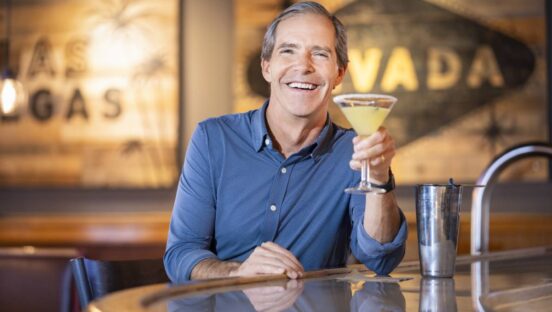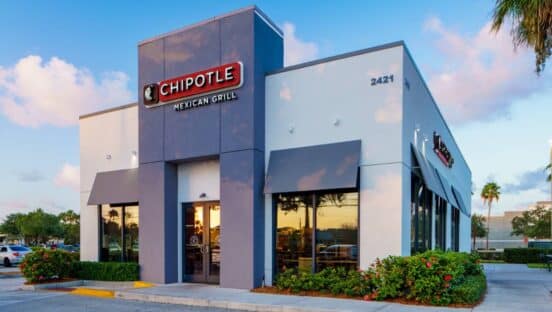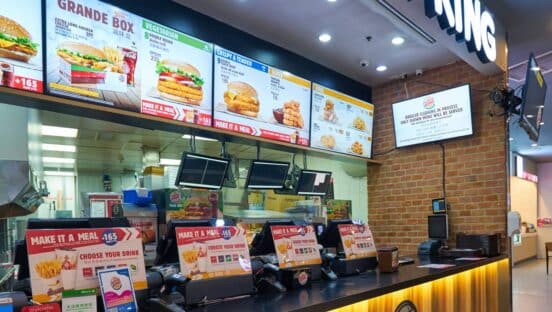Since the advent of the modern quick-service drive thru—some would say in the early 1970s, though the idea of a pick-up window has been around for much longer—operators have tinkered with the nuts and bolts to create a drive thru that is as fast, efficient, and pleasant as possible. Innovations throughout the years, from wireless headsets and order-confirmation boards to dual lanes and pre-sell signage, have created a better drive thru capable of handling the 60–70 percent of business that now loops the exterior of most quick-service restaurants.
With the Drive-Thru Performance Study, QSR—together with Columbus, Ohio–based Insula Research, which co-owns the proprietary report—has monitored the innovations and success of quick-serve drive thrus for the last 15 years. And since 2011, we’ve pared down the industry to a benchmark group, a set of six permanent brands—Burger King, Chick-fil-A, Krystal, McDonald’s, Taco Bell, and Wendy’s—along with one annually rotating brand—this year’s being Taco John’s—that regularly perform best in the drive-thru arena, to get a better idea of what companies can aspire to in the future.
Some trends have emerged from the benchmark group that signal an evolving drive-thru industry. Accuracy, for example, has topped out around 90 percent for most brands. Cleanliness and favorable exteriors are clearly a major investment in the industry. And order-confirmation boards (OCB) have become a preferred tool among brands not named Chick-fil-A.
This year, one additional thing became clear: Speed of service, it seems, may never be the same in quick-service drive thrus, especially among the benchmark group. McDonald’s experienced its slowest average speed of service in the history of the Drive-Thru Study, at 189.49 seconds; Chick-fil-A’s speed (203.88 seconds) was its slowest showing since 1998, Krystal’s (217.89) since 1999. Burger King was the only brand that improved speed of service over last year.
But that’s not to say the decline in speed is a bad thing. Times, of course, are changing. Food isn’t so simple anymore. Burgers and fries have become burrito bowls and customizable salad kits.
- Average Service Time
- Order Accuracy
- OCB in Place
- Pre-Sell in Place
- Impact of Pre-Sell
- Landscaping Condition
- Service Attributes
- Customer Service
- Suggestive Sells
- Suggestive Sells Timing
- Methodology
Free report download from King-Casey!
How to Compete at the Drive-Thru: You Need More Than Speed and Accuracy
“We knew going into this year’s Study that speed-of-service times seemed to have plateaued over the last few years, but we did not really expect to see the nearly across-the-board increases in service times that were apparent,” says Brian Baker, president of Insula Research. “One explanation for longer service times could be a more complex menu for operators to deal with, as many restaurants have introduced more healthy options that in some cases could take longer to prepare.”
Baker says slower service times can also be attributed to busier drive-thru lanes. Whether it’s due to increased overall interest in the quick-service industry or a shifting balance of traffic from the dining room to the drive thru, Baker says, the average number of vehicles in line during researchers’ trips through the drive thru was up over 2012. “The number of other vehicles in line for service is critical when assessing service speeds because it has such a dramatic impact on a restaurant’s ability to process any given customer,” he says.
That could help explain Chick-fil-A’s speed-of-service marks. The chicken chain had, on average, more than six cars in the drive-thru queue, far and away the most among the benchmark group and nearly a full vehicle more than the brand witnessed last year.
Mark Moraitakis, Chick-fil-A’s director of hospitality and service design, says the company is investing more in dual-lane drive thrus to better handle capacity issues. But he adds that it’s not just Chick-fil-A’s bumper-to-bumper drive-thru lanes that are slowing things down; the move toward more specialty sandwiches, he says, is also adding seconds to service time. And while Chick-fil-A does not willingly sacrifice speed of service to improve the broader drive-thru experience, he says, the company is rethinking the trip around the restaurant to enhance components that might, in turn, streamline the entire process.
“We can help team members be more operationally efficient; we also help them be more hospitable and show care and concern for the customer. So we’re trying to minimize any barriers that they might have so they can maximize their ability to connect with guests in a personal way,” Moraitakis says. “When you have Chick-fil-A team members who are making eye contact with you and listening to you, even through a speaker box, they’re more attentive, they’re more focused, they’re more likely to get it right … and they’re also more likely to get it out with much more grace and efficiency.”
Representatives from other benchmark brands also acknowledge that operational complexities might be pumping the brakes in the drive thru. But like Moraitakis and Chick-fil-A, they are rethinking the approach to speed as products evolve and the consumer experience becomes a more crucial component to drive-thru success.
Rob Savage, chief operations officer at Taco Bell, says the company is not trying too hard to speed up the drive thru because customers haven’t been complaining about its existing service time.
“You can get really fast but ruin the overall experience, because now you’re not friendly and now you’re not taking the time to guarantee accuracy or make sure the products have been built the way you want them to be built,” Savage says. “So there’s a careful balance in there that we have to continually look at through our testing process, through our food innovation labs, to make sure that the packaging we’re providing, the product builds, the tools we give, the training we give, is such that it will support our current speed targets but allow us to continue to improve on our experience, on our accuracy, on our friendliness.”
Of course, speed is still a top priority at benchmark brands, and they continue to design systems and procedures accordingly. For example, Wendy’s spokesman Denny Lynch says the company uses a separate grill and sandwich station in the drive thru to maintain its industry-best speeds, and it trains and cross-trains employees repeatedly to ensure the fastest speeds. Taco John’s, meanwhile, is revisiting its drive-thru layout to improve little things here and there that might impede the ability to service the drive thru quickly.
“We’re kind of going back to the basics and just looking at how we shave off seconds in our kitchens and make it more efficient for our employees, because they’re kind of taking too many steps,” says Shawn Eby, vice president of operations at Taco John’s. “Every little step adds an extra second, and that speed of service makes it longer and longer.”
[pagebreak]
“I think with speed, obviously you’ll hear people say, ‘Well if you improve by 10 seconds, you can add this much in sales,’” adds Carmen Gianguzzo, director of franchise operations at Taco John’s. “Speed is not the end game, but we do want to look at anything we can do to enhance that, whether it’s looking at standardized, new drive-thru menuboards that should help simplify the ordering process … [or] we want to eliminate anything that gets in the way of speed that isn’t critical toward quality or guest experience.”
Still, the industry’s evolution toward more complex menu items and consumers’ purchasing behaviors signal that speed-of-service times may never return to the highs of the mid-2000s heyday. And brands are discovering that even slight tweaks to the menu or operations can have a significant effect on speed of service in the drive thru.
Take Krystal as an example. The company’s average speed of service fell more than 40 seconds over last year’s 175.94-second showing. Krystal CEO Doug Pendergast, who joined the brand in 2012 and spearheaded its recent move from Chattanooga, Tennessee, to Atlanta, acknowledges that he didn’t expect speed of service to improve this year because the company has been undergoing several operational changes to improve the overall business.
“We have not had the time to focus on the drive thru as much as we’d like, but we have been able to build a new scorecard where we’re tracking every single score, every single day, week, period, and quarter, based on the window time,” Pendergast says, noting that the company focuses mostly on window speed of service so as not to rush customers at the ordering station. “So I think we now have the leadership in place, the data in place, to begin to systematically improve what we’re doing.”
- Average Service Time
- Order Accuracy
- OCB in Place
- Pre-Sell in Place
- Impact of Pre-Sell
- Landscaping Condition
- Service Attributes
- Customer Service
- Suggestive Sells
- Suggestive Sells Timing
- Methodology
Free report download from King-Casey!
How to Compete at the Drive-Thru: You Need More Than Speed and Accuracy
Pendergast adds that Krystal has experienced a shift in its menu mix, with more customers purchasing bulk orders of Krystal’s signature sliders.
“Right now, as an example, over 20 percent of our sales are multi-packs—12 packs, 24 packs of Krystals,” he says. “That’s a pretty significant increase from what it was when we came into the company just over a year ago. That’s a little bit more of a challenge to execute in a drive-thru environment. So we’re working on the changes and procedures, layout, and production to make that happen.” He says the company is developing a new store prototype that reconfigures the drive-thru set-up; tests have shown that the new prototype cuts about 20 seconds off the Krystal drive-thru experience.
Eby says Taco John’s internal speed-of-service benchmark in the drive thru is 180 seconds, almost exactly its measured time (181.19 seconds) in this year’s Study. But he adds that the figure is not set in stone, as speed of service is a fluid metric that evolves across the system.
“I think for guests, they want it fast, but everyone’s perception of fast is different,” he says. “But they absolutely want the order correct, and they want the food hot and fresh, so you have to have a combination of those. But the first two come
before speed.”
If operators were to formally rank their priorities, accuracy would likely be No. 1 at each of the benchmark brands. It doesn’t matter how fast you get the food out, brand reps say; if the order is wrong, the whole experience turns sour.
Accuracy has come a long way since the Drive-Thru Study’s inaugural year. In 1998, accuracy ratings for today’s benchmark brands were as low as 61.8 percent and only as high as 83.9 percent. Today, their accuracy ratings range from 79.5 to 91.6 percent. Even though accuracy has slipped slightly since last year—average order accuracy at benchmark brands last year was 88.8 percent, compared with 87.2 percent this year—operators are still laser-focused on making sure the right food is being served to the right cars.
Similar to speed of service, the complexities involved with new menu items are affecting the way the benchmark brands approach accuracy in the drive thru. Lynch uses Wendy’s Berry Almond Chicken Salad as an example of a premium product that throws a wrench into the drive-thru process. The salad comes with dressings, almonds, and croutons in separate packages and can be customized based on how the customer designs the order. “Those things, the customer likes, but it makes it tougher in the drive thru to make sure you have all of the condiments and the extra ingredients that go with the whole meal,” Lynch says. “So order accuracy becomes a constant point of emphasis.”
Savage shares a similar story in regards to Taco Bell’s new Cantina Bell menu. The burritos and bowls have nearly 10 ingredients, he says, making it the most complex product line the chain serves. Taco Bell has rolled out special training procedures to ensure employees are able to consistently serve the right product. Another system that ensures accuracy at Taco Bell is a triple-check system, Savage says. At most restaurants, orders are confirmed through an OCB, the crewmember repeating the order to the customer over the speaker box, and then an employee repeating the order one final time at the pick-up window.
“In our best circumstance, they repeat the order back to the customer and say, ‘Here are your two Doritos Locos Tacos and your Cantina Bowl,’” Savage says. “So you as a customer felt good when you ordered it, because we guaranteed on the screen and when we brought it up to you, and then when it’s being handed to you at the drive thru. You feel good that we paid attention to your order specifically because that team member is presenting it to you.”
While accuracy percentages in the Study can be affected by mistakes that OCBs cannot control—missing napkins, for example, or inaccurate change—the boards are increasingly employed by the benchmark brands to improve accuracy in the drive thru. The vast majority of Burger King, McDonald’s, and Wendy’s units studied this year had an OCB in place, while the share of Taco Bell restaurants with one in place grew over last year.
Chick-fil-A has famously opted against using OCBs; the brand only has the boards in place at 11.7 percent of its restaurants. Moraitakis says the company is leveraging people over technology under the belief that employees firing on all cylinders can be plenty fast and accurate.
“I think there’s a concern that speed of service could slow down [with OCBs],” he says. “We can think of what all the reasons are you would want an order-confirmation board, and then … design the experience that gives you those without that actual technology. That’s been our philosophy at this point as we’ve thought through all the ways we can enhance the drive-thru experience. We’d rather people be our confirmation board.”
[pagebreak]
Moraitakis says this same philosophy encourages Chick-fil-A crewmembers to design the drive-thru experience around each customer. He says employees are trained to listen for clues in each customer’s voice; if she sounds rushed and knows precisely what she wants, she’s probably in a hurry and should be accommodated. If the customer sounds like he’s in a playful mood, the crew is given the license to be playful back. And if it’s a familiar voice, employees are encouraged to recognize the regulars.
That customer-service component has become a well-known signature at Chick-fil-A, and other benchmark brands are trying to replicate the model to similarly boost the overall drive-thru experience.
At Taco John’s, for example, a major focus in the coming year is on the guest interaction in the drive thru, Gianguzzo says. “We don’t want our guests to feel rushed, but we want to enhance their meal. So if there is a suggestive selling opportunity to complete a meal, we obviously want to do that,” he says. “At the same time, we don’t want to try to sell them 10 things either. All of a sudden we sound like a used car salesman trying to add on everything. So we want that experience to be pleasant, we want it to be genuine. We don’t want [employees] to sound like a robot where they’re saying the same thing to every single guest. And we want those pleasantries.” (For more on customer service in the drive thru, click here.)
- Average Service Time
- Order Accuracy
- OCB in Place
- Pre-Sell in Place
- Impact of Pre-Sell
- Landscaping Condition
- Service Attributes
- Customer Service
- Suggestive Sells
- Suggestive Sells Timing
- Methodology
Free report download from King-Casey!
How to Compete at the Drive-Thru: You Need More Than Speed and Accuracy
Along with improved customer service, menuboards and signage in the drive-thru lane can help streamline the process by making the purchase decision easier for customers, the benchmark brands say. Wendy’s, for one, is working in cleaner, better-organized menuboards with more pictures as part of its broader store remodeling, Lynch says.
Various other drive-thru strategies are being tested and employed at quick serves across the country: digital menuboards, dual drive-thru lanes, remote order takers during rush. And operators continue to keep one eye on the future as they roll out affordable and effective technologies.
“I think you’re going to see more restaurant chains experimenting with mobile payments off your mobile device,” Lynch says. “Conceivably, you could load up your favorite meal into your app and when you get to the restaurant at the order station, you just flash your app and all of a sudden, boom, your order is delivered.”
How that will evolve speed of service in the drive thru remains to be seen.















